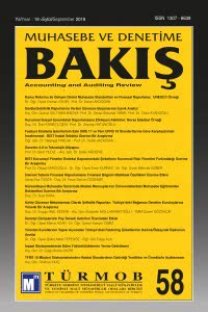GELECEK DÖNEM NAKİT AKIŞI TAHMİNİNDE DÖNEM KÂRI VE NAKİT AKIŞI KARŞILAŞTIRMASI
Kâr, Nakit Akışı, Gelecek Dönem Nakit Akışı
Earnings, Cash Flows, Future Period Cash Flows,
___
- Aktaş, H. (2009). Hisse senetleri piyasasında muhasebe bilgilerinin önemi: İMKB’de değer ilişkisi analizi: Gazi Kitabevi.
- Aktaş, R. ve Karğın, S. (2012). Predictive Ability of Earnings and Cash Flows: Evidence from Turkish Firms’
- Cash Flow Statements Prepared by IAS 7. Journal of Money, Investment and Banking, 25, 171-180. Arthur, N., Cheng, M. ve Czernkowski, R. (2010). Cash flow disaggregation and the prediction of future earnings.
- Accounting & Finance, 50(1), 1-30. Baginski, S. P., Lorek, K. S., Willinger, G. L. ve Branson, B. C. (1999). The relationship between economic characteristics and alternative annual earnings persistence measures. The Accounting Review, 74(1), 105-120.
- Bandyopadhyay, S. P., Chen, C., Huang, A. G. ve Jha, R. (2010). Accounting conservatism and the temporal trends in current earnings’ ability to predict future cash flows versus future earnings: evidence on the trade off between relevance and reliability. Contemporary Accounting Research, 27(2), 413-460.
- Barth, M. E., Clinch, G. ve Israeli, D. (2016). What do accruals tell us about future cash flows? Review of
- Accounting Studies, 21(3), 768-807. Barth, M. E., Cram, D. P.,ve Nelson, K. K. (2001). Accruals and the prediction of future cash flows. The accounting review, 76(1), 27-58.
- Board, F. A. S. (1978). Statement of Financial Accounting Concepts No. 1. Objective of Financial Reporting by
- Business Enterprises. Bollerslev, T., Xu, L. ve Zhou, H. (2015). Stock return and cash flow predictability: The role of volatility risk.
- Journal of Econometrics, 187(2), 458-471. Burgstahler, D. ve Dichev, I. (1997). Earnings management to avoid earnings decreases and losses. Journal of accounting and economics, 24(1), 99-126.
- Chang, A. C.-C., Kumar, P. ve Sivaramakrishnan, S. (2006). Dividend changes, cash flow predictability, and signaling of future cash flows.
- Cheng, C. A. ve Hollie, D. (2008). Do core and non-core cash flows from operations persist differentially in predicting future cash flows? Review of Quantitative Finance and Accounting, 31(1), 29-53.
- Cleary, S. (1999). The relationship between firm investment and financial status. The Journal of Finance, 54(2), 692.
- Damodaran, A. (2016). Damodaran on valuation: security analysis for investment and corporate finance (Vol. ): John Wiley & Sons.
- Dechow, P. M., Kothari, S. P. ve Watts, R. L. (1998). The relation between earnings and cash flows. Journal of
- Accounting and Economics, 25(2), 133-168. Dechow, P. M., Sloan, R. G. ve Sweeney, A. P. (1995). Detecting earnings management. Accounting review, 193
- Dechow, P. M., Sloan, R. G. ve Sweeney, A. P. (1996). Causes and consequences of earnings manipulation: An analysis of firms subject to enforcement actions by the SEC. Contemporary accounting research, 13(1), 1-36.
- Finger, C. A. (1994). The ability of earnings to predict future earnings and cash flow. Journal of accounting research, 210-223.
- Greenberg, R. R., Johnson, G. L. ve Ramesh, K. (1986). Earnings versus cash flow as a predictor of future cash flow measures. Journal of Accounting, Auditing & Finance, 1(4), 266-277.
- Gujarati, D. N. (2009). Basic econometrics: Tata McGraw-Hill Education.
- Jones, J. J. (1991). Earnings management during import relief investigations. Journal of accounting research, 193
- Kim, M. ve Kross, W. (2005). The ability of earnings to predict future operating cash flows has been increasing— not decreasing. Journal of accounting research, 43(5), 753-780.
- Lang, L. H., Stulz, R. ve Walkling, R. A. (1991). A test of the free cash flow hypothesis: The case of bidder returns. Journal of Financial Economics, 29(2), 315-335.
- Moeinaddin, M., Ardakani, S. ve Akhoondzadeh, F. (2013). Examination of the ability of earning and cash flow in predicting future cash flows. Interdisciplinary Journal of Contemporary Research In Business, 4, 94-101.
- Orpurt, S. F. ve Zang, Y. (2009). Do direct cash flow disclosures help predict future operating cash flows and earnings? The Accounting Review, 84(3), 893-935.
- Skinner, D. J. (2004). What do dividends tell us about earnings quality. Unpublished working paper. University of
- Michigan, Ann Arbor, Michigan. Sloan, R. (1996). Do Stock Prices Fully Reflect Information in Accruals and Cash.
- Takhtaei, N. ve Karimi, H. (2013). Relative ability of earnings data and cash flow in predicting future cash flows.
- International Journal of Accounting and Financial Reporting, 3(1), 214.
- ISSN: 1307-6639
- Yayın Aralığı: Yılda 3 Sayı
- Başlangıç: 2000
- Yayıncı: TÜRMOB
KAR YÖNETİMİNİN DÜZELTİLMİŞ JONES MODELİYLE ÖLÇÜMÜ: BIST’TE BİR UYGULAMA
İŞLETME KÖRLÜĞÜ VE ÇÖZÜM ÖNERİSİ OLARAK GÜVENİLİR DANIŞMAN “İÇ DENETİM”
Burcu ÖZGÜL, Banu Tarhan MENGİ
Murat GÖRMEN, Mustafa SAVCI, Barış AYDEMİR
Engin ERGÜDEN, Can Tansel KAYA, Begüm TANYER, Mete TÜRKYILMAZ
GELECEK DÖNEM NAKİT AKIŞI TAHMİNİNDE DÖNEM KÂRI VE NAKİT AKIŞI KARŞILAŞTIRMASI
2014-2016 YILLARI ARASINDA BIST ŞİRKETLERİ İLE İLGİLİ DENETİM GÖRÜŞLERİ
Nalan AKDOĞAN, Elif Senem GÜDÜ, Ayşe IŞIK, İrem SEVİNDİK, Derya ŞAHİN, Gülşen ÖZKAN
Fatih COŞKUN ERTAŞ, Ergin TEMEL
TÜRKİYE’DE YERLİ MEVDUAT BANKALARINDA SERMAYE YETERLİLİĞİ VE KARLILIK İLİŞKİSİ
NİLGÜN ACAR BALAYLAR, Mehmet Ozan ÖZDMİR
COSO KURUMSAL RİSK YÖNETİMİ ÇERÇEVESİ GÜNCELLEME PROJESİNİN GETİRDİĞİ YENİLİKLER
